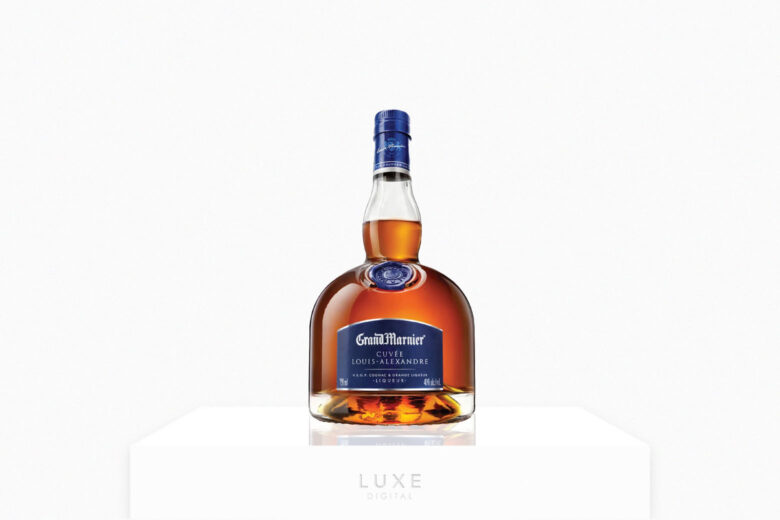When you invent something, and place the adjective ‘grand’ in the title, it had better be really, really good. Fortunately, the equally grand-sounding Louis-Alexandre Marnier Lapostolle appears to have exceeded expectations with his revered brandy liqueur; the aptly named Grand Marnier.
Born in 1880, on the outskirts of Paris, Grand Marnier Cordon Rouge is the result of a genius blending of distilled bitter orange essence, cognac brandy, and sugar. As a curaçao similar to Cointreau, it’s commonly used to add a sweet, citrusy kick to a classic margarita.
Although, with a little creativity, Grand Marnier’s talents are much further reaching. The bittersweet orange liqueur can add a sense of French sophistication to hot chocolates, sangria, and champagne to craft memorable liquid delights.
As per French reputation demands, Grand Marnier continues to ooze prestige and poise at every bar and table on which it’s found.

Grand Marnier bottle sizes and prices
| Bottle | Size | Price (USD) |
|---|---|---|
| Grand Marnier Cordon Rouge | 750ml | $41 |
| Grand Marnier Cordon Rouge | 1 liter | $47 |
| Grand Marnier Cordon Jaune | 1 liter | $50 |
| Grand Marnier Quintessence | 750ml | $800 |
| Grand Marnier Cuvée Louis Alexandre | 700ml | $75 |
| Grand Marnier Cuvée du Centenaire | 700ml | $209 |
| Grand Marnier Cuvée 1880 | 750ml | $359 |
The story of Grand Marnier
You could say Louis-Alexandre Marnier-Lapostolle was destined to become a master distiller.
He was born into a winemaking family in Sancerre, and so was familiar with the art of fermentation.
As a young man, he became interested in distillery, and landed a job as an assistant in a fruit liqueur distillery in Neauphle-Le-Château, on the outskirts of Paris. Incidentally, the distillery was owned by his new wife, Julia’s, grandfather.
Jean-Batiste Lapostolle had established the distillery back in 1827 and had enjoyed modest success. Little did he know, by welcoming Louis-Alexandre into both his employ and his family, his small factory would become the birthplace of one of the world’s favorite liqueurs.
Hey, sometimes nepotism works out just fine.

A revolutionary idea
Louis-Alexandre was quite the eccentric. After brainstorming ideas for a new liqueur, he suggested something that seemed totally unorthodox.
His idea was to blend refined French Cognac with a rare type of bittersweet orange from the Caribbean. As we know, the result was delicious.
So, one fine day in 1880, Louis-Alexandre Marnier Lapostolle cemented himself as a key member of the Marnier-Lapostolle distillery family by creating the most famous drink to ever leave the quaint factory.
Sure, that’s one way to impress your in-laws.
Grand by reputation
Being both an excellent networker and a prominent member of society, Louis-Alexandre regularly shared a glass or two of Cognac with Cesar Ritz, of the Ritz Hotel. Both men respected each other’s work and shared mutual admiration of one another.
So, when it came time to name Louis-Alexandre’s fine new liqueur, it was Ritz who exclaimed, “Grand Marnier! A grand name for a grand liqueur!”. Of course, the name stuck.

La Belle Époque
Presumably in part thanks to Grand Marnier’s friends in high places, the bitter orange liqueur became a new favorite in haute societé during the famous Belle Époque period in Paris.
A time of unbridled decadence demanded only the finest of alcohols to be served, and a party wasn’t a party without several bottles of Grand Marnier bedecking the tables.
Elegant glasses of Grand Marnier could be ordered by affluent guests at hotels such as the Savoy Hotel and the Ritz Hotel, further fixing its reputation as a mainstay in bourgeois circles.

Grand Marnier types
Although Grand Marnier Cordon Rouge is undeniably the most well-known of the distillery’s liqueurs, there has been a range of the French liqueur to come out of la maison.
Grand Marnier Cordon Jaune
Cordon Jaune (or “Yellow Ribbon”) looked strikingly similar to Cordon Rouge. However, as the name suggests, it was housed in a label with yellow highlights, yellow ribbon, and a yellow wax seal.
Closer to a triple-sec than its scarlet counterpart, Cordon Jaune was made with a neutral grain spirit rather than brandy. In fact, it was the original form of the famed Cordon Rouge. Louis-Alexandre added Cognac to the recipe later down the line.
Unfortunately, the orange brandy-less liqueur’s production was halted in 2017. However, if you look hard enough, you might just find an errant bottle…

Grand Marnier Quintessence
If you adore the finer things in life, the Grand Marnier Quintessence might satisfy your thirst for all things opulent.
Released in 2011, only 2,000 bottles were created. So, if you locate one of these elusive bottles on the market, you’ve won the liqueur lottery.
Expertly crafted from 20 of the finest, oldest cognacs (we’re talking between 25 and 135 years old) from the Grand Champagne region of France, Grand Marnier Quintessence is, well, quintessentially Grand Marnier.
Famed for its rich, smoky, citrus notes and golden hue, a ‘double perfume’ method was used to extract sharp flavor from orange peels. This was then blended with the cognacs to create a highly sought-after spirit.
Oh, and it will only set you back around $800.

Grand Marnier Cuvée Louis Alexandre
An exquisite blend of aged, premium XO Cognac and the requisite bitter orange essence, the Grand Marnier Cuvée Louis Alexandre was specially crafted to commemorate its inventor.
Renowned for its smoothness, the eponymous liqueur offers hints of candied orange, bergamot, and pine, with a languorous finish. Louis Alexandre would be proud.

Grand Marnier Cuvée du Centenaire
In honor of the distillery’s centenary year, Grand Marnier Cuvée du Centenaire was released in 1927.
Only the finest rare Cognacs from the Champagne regions of France were permitted to grace the ingredients list, along with tropical wild orange essence alluding to faraway lands.

Grand Marnier 1880
Before this copper liquid touches your lips, you’ll notice the striking bottle in which it’s held: The elaborate glass vessel celebrates La Belle Époque, complete with art deco embellishments.
The dominant Cognac notes supply a dry profile with just a whisper of aromatic bitter orange, feeling more adult than its sweeter siblings.

Grand Marnier vs Cointreau
Ah, the age-old question. While Cointreau works well as a Grand Marnier substitute in cocktails, and both possess an ABV of 40% (80 proof), both liqueurs possess subtly different characteristics:
- Both spirits are categorized as orange liqueurs, and both were formulated in the 19th Century as variations of a curaçao-based spirit, hailing from the eponymous Caribbean island.
- The base spirit of Cointreau is beet sugar alcohol, and the subsequent ‘clean’ flavor is considered ideal for cocktails. On the other hand, Grand Marnier’s base spirit is high-quality Cognac, which contributes hugely to the liqueur’s complex orange, oak, and vanilla flavors.
- Grand Marnier is considered a hybrid of triple sec and Curaçao, while Cointreau sits firmly in the triple sec-style category.
How to drink Grand Marnier
There are countless Grand Marnier cocktails with which to experiment, but it is best enjoyed neat, with no ice.
Simply pour 30ml of Grand Marnier into a short glass, swirl around, and sip slowly to appreciate the complex flavors.

Best cocktails to make with Grand Marnier
Sometimes, triple sec or orange liqueur can be interchangeable in cocktail recipes. However, here are a few recipes where Grand Marnier is the star of the show.
Grand 75

Ingredients:
- 45ml Grand Marnier
- 20ml lemon juice
- 1 tsp sugar syrup
- Dry champagne to top up
- Orange zest
Cocktail recipes: Build all ingredients in a child champagne flute, stir gently, and garnish with orange zest.
Grand Marnier Margarita

Ingredients:
- 15ml Grand Marnier
- 60ml tequila
- 30ml fresh lime juice
- 15ml agave syrup
- Lime wheel and salt to garnish
Cocktail recipes: Combine all ingredients in a cocktail shaker with ice and shake well. Strain into a chilled martini glass with a salted rim, and garnish with lime wheel.
Corpse Reviver

Ingredients:
- 15ml Grand Marnier
- 30ml gin
- Half a lemon, juiced
- 15ml sugar syrup
- 15ml Sauvignon Blanc
- Splash of absinthe
- Maraschino cherry
Cocktail recipes: Combine gin, Grand Marnier, sugar syrup, and Sauvignon Blanc wine in a cocktail shaker, then add the lemon juice. Add ice and shake vigorously, then strain into a coupe glass. Garnish with a cherry.
Frequently asked questions about Grand Marnier
Grand Marnier is a brilliant ingredient in many cocktails which call for an ‘orange liqueur’. However, it’s best enjoyed neat and at room temperature, in order to fully appreciate the smoky, bitter orange and vanilla flavor notes.
Grand Marnier is great in margaritas, but it also complements the flavors of gin, tequila, and sparkling wines as well as spicing up a regular hot chocolate, or adding zong to a pitcher of sangria.
At 40% ABV, Grand Marnier is safe to drink straight, so long as you do so in moderation. Pour a serving into a short glass and sip slowly.
Cointreau is the quintessential triple sec brand, however Grand Marnier is considered a hybrid of triple sec and curaçao, and can be used in recipes as a triple sec.
The Grand Marnier price sits around the $30 mark for a 750ml bottle of Cordon Rouge. However, you can spend up to $800-900 on a limited edition Grand Marnier Quintessence.
A 750ml bottle of Grand Marnier Cordon Rouge is roughly $30, while the Cordon Jaune is typically around $50, and Grand Marnier Quintessence is around the $800 mark.












